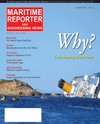
Page 38: of Maritime Reporter Magazine (February 2012)
Cruise Shipping Annual
Read this page in Pdf, Flash or Html5 edition of February 2012 Maritime Reporter Magazine
38Maritime Reporter & Engineering News SATELLITE COMMUNICATIONS FEATURE Cleaning Up Our Waters Now in its fourth year, Project Kaisei has come to rely upon satellite commu-nications for effective communication with colleagues ashore as well as itsglobal support base. Mary Crowley talks about how the project?s requirements for communications are continuously evolv- ing. In the digital age it is easy to take for granted the benefits that reliable connec- tivity provides. In the maritime industry alone, always-on communications are supporting a wealth of applications to im-prove operational efficiency and crew welfare. But even today, the availability of modern communications capabilitiesis not guaranteed in some remote loca-tions, which is why North Pacific Gyre cleaning operation ?Project Kaisei? was pleased to collaborate with Marlink andSea Tel for its satellite communications services. ?Being able to communicate with ourteams ashore during our expedition is vital to the success of the mission,? said Mary Crowley Director of Ocean Voy- ages Institute, and Co-Founder of Project Kaisei. ?We depend on real-time updates from oceanographers and weather ex- perts to help us locate areas of the great-est accumulations of plastic trash. Con-tinued support from Marlink and Sea Tel is instrumental in helping to achieve our duel missions of education related to theglobal problem and to stop the flow of debris into the ocean to begin actual clean-up expeditions.? DEBRIS COLLECTION Set-up by Ocean Voyages Institute of California in 2008, a California 501(c)3non-profit organization, Project Kaisei is the ?Ocean Clean-up initiative? of the In- stitute, focused on increasing awareness of the scale of marine debris, its impacton the environment and the solutions for both prevention and clean-up. The proj- ect aims to prevent further accumulation of marine debris in the ocean and applynew technologies to begin removing this waste. Project Kaisei?s research findings have identified that debris falls into four major categories. One: Ghost nets/derelict fishing gear, Two: Floating consumer debris, rang- ing from car fenders to large plastic storage bins, plastic bottles and con-tainers of all shapes and sizes,Three: Smaller plastic debris, ranging from tooth brushes to children's toys to broken down pieces of plastic, and Four: Micro plastics. According to the project team, the fourdebris categories each present different challenges for clean-up that require tech-nologies to be created and modified to find the best devices for extracting these different categories of debris. Having the availability of the satellite communica- tions link is fundamental to the continueddevelopment of this global initiative and gives clean-up operations the ability to communicate and modify clean-up tech-nologies being tested while at sea.?Having the ability to send reports, photos and film from the ship makes a significant difference to the effectiveness of our operations,? continues Crowley. ?Satellite communications allows us to take advantage of a whole host of appli- cations. We also use it to keep track of weather patterns which influence debrisdistribution as well as communicate through blogs and email to provide the latest news, photographs and videos to our supporters worldwide.? BETTER CONNECTED 2011 marks the third Project Kaisei ex- pedition that Marlink and Sea Tel will support with the donation of VSAT equipment and services. ?2009 was the first expedition that Marlink and Sea Tel supported and our ability to send text, photos and video in real time, greatly en-hanced exposure of the project, helping to raise awareness of our cause,? said Crowley. ?During this voyage we were able to take part in several live radio interviews while sailing in the middle of the Pacific Ocean through our satellite communica-tions system. The ability to communicate to audi-ences from our remote location and relaylive what we were experiencing greatly contributed to the timeliness of the news, making it more relevant and dramatic. In today?s world with so much going on in terms of global news, the ability to com- municate from the middle of the oceanwhile conducting studies of the debrisissue is vital to gaining the media?s at- tention and support.? Crowley continues: ?Our vessel tracker application also relied heavily upon our Marlink, Sea Tel Support North Pacific Gyre Clean-up Project MR Feb.12 # 5 (34-41):MR Template 2/7/2012 10:39 AM Page 38

 37
37

 39
39
